This post contains affiliate links.
What types of hummingbirds are found in Texas?
There are 20 species of hummingbirds found in Texas:
- Allen’s
- Amethyst-throated Mountain-gem
- Anna’s
- Berylline
- Black-chinned
- Blue-throated Mountain-gem
- Broad-billed
- Broad-tailed
- Buff-bellied
- Calliope
- Cinnamon
- Costa’s
- Green-breasted Mango
- Lucifer
- Mexican Violetear AKA Green Violetear
- Rivoli’s AKA Magnificant
- Ruby-throated
- Rufous
- Violet-crowned
- White-eared
These 20 hummingbird species found in Texas are further categorized into 3 groups: Year-round residents, seasonal, and rare/vagrants.
The chart below shows hummingbird Texas sightings from the most to the least seen.
| Year-Round: | Out of 10,000 | Out of All |
| Buff-bellied | 1,381 | 13% |
| Broad-tailed | 209 | 2% |
| Calliope | 65 | 0.6% |
| Allen’s | 34 | 0.3% |
| Berylline | 1 out of 425,000 | 0.001% |
| Seasonal: | ||
| Ruby-throated | 4,015 | 40% |
| Black-chinned | 3,3368 | 33% |
| Vagrant: | ||
| Rufous | 664 | 6.6% |
| Anna’s | 91 | 0.9% |
| Lucifer | 72 | 0.7% |
| Blue-throated | 36 | 0.3% |
| Broad-billed | 22 | 0.2% |
| Rivoli’s | 20 | 0.2% |
| Mexican-violetear | 6 | 0.05% |
| Green-breasted | 5 | 0.05% |
| Costa’s | 4 | 0.04% |
| Violet-crowned | 3 | 0.03% |
| White-eared | 3 | 0.03% |
| Amethyst-throated | 1 out of 400,000 | 0.0005% |
| Cinnamon | 0 | 0 |
Texas is home to hummingbirds of different geographic ranges, temperaments, varied nesting habitats, and diverse coloring. In the Lone Star State hummingbirds are a grand attraction and an enthusiastic common pastime activity, shared by everyone.
The people of Texas love hummingbirds and take great pride in hosting the annual Hummingbird Festival (HummerBird Celebration) in Rockport-Fulton, Texas. Every year during the month of September the community comes together to commemorate and observe the spectacular occurrence of the Ruby-throated hummingbird’s fall migration as they make their way south to winter in Mexico.
What are the most common hummingbirds seen in Texas?
Ruby-throated hummingbirds are the most common hummingbird seen in Texas at 40% of all hummingbirds.
Black-chinned hummingbirds are the second most common at 33% of all hummingbirds seen in Texas.
Buff-bellied hummingbirds are the third most common at 13% of all hummingbirds seen in Texas.
Year-Round/Native Hummingbirds in Texas:
This hummingbird classification is defined as hummingbirds that are year-round residents residing in Texas 365 days a year.
The five hummingbirds seen in Texas that are classified as Year-round/Natives are:
- Buff-bellied
- Broad-tailed
- Calliope
- Allen’s
- Berylline
The Ruby-throated hummingbird is an exception, it overwinters in Texas but migrates north during the months of June and July and is reportedly not seen in Texas during these months, therefore I have placed it in the seasonal category.
Below are the seasonal Texas hummingbird sightings listed from the most to the least seen.
BUFF-BELLIED HUMMINGBIRD – (Amazilia yucatanensis)
Conservation Status: Least concerned
Kingdom: Animalia
Phylum: Chordata
Class: Aves
Order: Apodiformes
Family: Trochilidae
Genus: Amazilia
Species: A. yucatanensis
The Buff-bellied hummingbird is one of the five year-round residents to Texas. The others include Broad-tailed, Allen’s, Berylline, and Calliope. They are most commonly seen in Texas, especially during the hot summer months.
On average, out of 10,000 hummingbird sightings in Texas, only 1,381 will be Buff-bellied hummingbirds. Out of all hummingbird sightings in Texas, 13% will be Buff-bellied hummingbirds.
See Texas Buff-bellied sightings map
The Buff-bellied hummingbird travels frequently to the United States near the southern Mexican border. They usually reside in Mexico and as far south as Guatemala during the winter.
Male Buff-bellied hummingbirds sport a bluish-grey-turquoise gorget. They are identified as having a metallic iridescent bronze olive green back with a rusty brownish gold forked tail. Their dark brown wings can look black in certain lighting. They have a reddish-orange bill with a black tip and their underbelly is chestnut in color. Their size is a medium build ranging from 3.9 inches to 4.3 inches in length and weighs 4-5 grams.
Female Buff-bellied hummingbirds usually are more drab-looking and less showy than the males and usually do not have iridescent feathers.
They prefer to nest in large shrubs or deciduous trees that have dense foliage and forgiving tree branches useful for building a nest.
According to Texas A&M AgriLife Research, Buff-bellied hummingbirds prefer to nest in trees such as Anachuita, Ebony, Hackberry, and sometimes Willows.
Juvenile Buff-bellied hummingbirds, both male and female, look more like adult females until they are differentiated as the male begins to acquire the iridescent feathers that are typical of this species of hummingbird. The juvenile’s throat and chest show a duller gray tone in color.
Baby Buff-bellied hummingbirds are easily identified by their white fluffy feathers near their bottom that will disappear as they age.
Buff-bellied hummingbirds crossbreed with Berylline and Rufous hummingbirds.
During a capture and release banding operation in Texas, the oldest living recorded male Buff-bellied hummingbird was 11 years and 2 months.
See my article: 3 Reasons Why Hummingbirds Are Banded
See pictures of male, female, and juvenile Buff-bellied hummingbirds
Hear the sounds of Buff-bellied hummingbirds
BROAD-TAILED HUMMINGBIRD – (Selsaphoris platycercus)
Conservation Status: Least concerned
Kingdom: Animalia
Phylum: Chordata
Class: Aves
Order: Apodiformes
Family: Trochilidae
Genus: Selsaphoris
Species: S. platycercus
The Broad-tailed hummingbird is one of the five year-round residents to Texas. The others include Allen’s, Berylline, Buff-bellied, and Calliope.
The Broad-tailed hummingbird also travels frequently to the United States near the southern Mexican border. They usually reside in Mexico and as far south as Guatemala during the winter.
On average, out of 10,000 hummingbird sightings in Texas, 209 will be of the Broad-tailed hummingbird. Out of all hummingbird sightings in Texas, 2% will be Broad-tailed hummingbirds.
See Texas Broad-tailed sightings map
It is amazing to realize in comparing the top 2 commonly seen hummingbird species in Texas out of 10,000 hummingbird sightings, 1,381 will be Buff-bellied while only 209 will be Broad-tailed hummingbirds.
Male Broad-tailed hummingbirds have an iridescent ruby-red gorget. Both males and females Broad-tailed hummingbirds have green topside and pale underbellies with bright white eye rings and broadly rounded tails. Their size is medium build and ranges from 3.3 inches to 3.8 inches in length and weigh 3.6 grams.

Photo by: bird.whisperer
Female Broad-tailed hummingbirds do not have a gorget or iridescent feathers and are less vibrant than the males. They have green topsides from their head to their tail and pale to beige underbellies with bright white eye rings and broadly rounded tails.
Juvenile Broad-tailed hummingbirds, both male and female, look more like adult females until they are differentiated as the male begins to acquire the iridescent feathers that are typical of this species of hummingbird.
Baby Broad-tailed hummingbirds are easily identified by their white fluffy feathers near their bottom that will disappear as they age.
The Broad-tailed hummingbird travels frequently to the United States near the southern Mexican border.
They have a migrant and non-migrant population that begins in the south of Mexico. The ones that migrate north to breed will do so during spring migration and will pass through Arizona, Colorado, Wyoming, and Idaho and reach as far north as Montana.
Once the breeding season is complete, Broad-tailed hummingbirds will depart and begin their southbound fall migration to winter in Mexico and meet up with their non-migrant population.
See my article: Hummingbird Migration in Texas
The Broad-tailed hummingbird favors habitats in the understory of mature forest woodlands such as pine and oak groves. They chose to nest on the branches of trees and have been known to return to the same nesting ground each year, roughly 70% of the time.
Their breeding time coincides with the peak time of flowering native plants for maximum food resource availability. Their favorite nectar-producing flower plants include Red Columbine, Indian Paintbrush, Sage varieties, Currants, and Scarlet Mint.
They hybridize and readily crossbreed with other hummingbird species, such as the Costa’s hummingbird.
The Broad-tailed hummingbird has suffered a decline in population since the 1990s, but presently, its population is stable, and it has been shown to have adapted to human habitat encroachment.
During a capture and release banding operation in Colorado, the oldest living recorded female Broad-tailed hummingbird was 12 years and 2 months.
See my article: 3 Reasons Why Hummingbirds Are Banded
See pictures of male, female, and juvenile Broad-tailed hummingbirds
Hear the sounds of Broad-tailed hummingbirds
CALLIOPE HUMMINGBIRD – (Selasphorus calliope)
Conservation Status: Least concerned
Kingdom: Animalia
Phylum: Chordata
Class: Aves
Order: Apodiformes
Family: Trochilidae
Genus: Selasphorus
Species: S. calliope
Calliope hummingbirds are seen mainly in the Western United States. On average, out of 10,000 hummingbird sightings in Texas, 65 will be of the Calliope. Out of all hummingbird sightings in Texas, 0.6% will be Calliope hummingbirds.
See the Texas Calliope sightings map
Calliope hummingbirds over-winter in Texas but are rarely seen in June.
I have placed them in the year-round category with the caveat of the above statement.
Calliope hummingbirds are named after a Greek mythological muse, who represented poetry and eloquence. Calliope means “beautiful voice” in ancient Greek.
Male Calliope hummingbirds are easily identified by their iridescent purple crown and long striking spaced outline row of feathers that project down the sides of their throat. Like many hummingbirds, the backs are metallic green and these birds measure 3 inches in length and weigh 2-3 grams.

Photo by: sony_alpha_male

Photo by: Bob Free
Female Calliope hummingbirds do not have a gorget or iridescent feathers and are less vibrant than the males. The crown or the top of their head is gray-green in color. The flanks which are the sides and underbelly or behind the wings are buff in color.

Photo by: sony_alpha_male
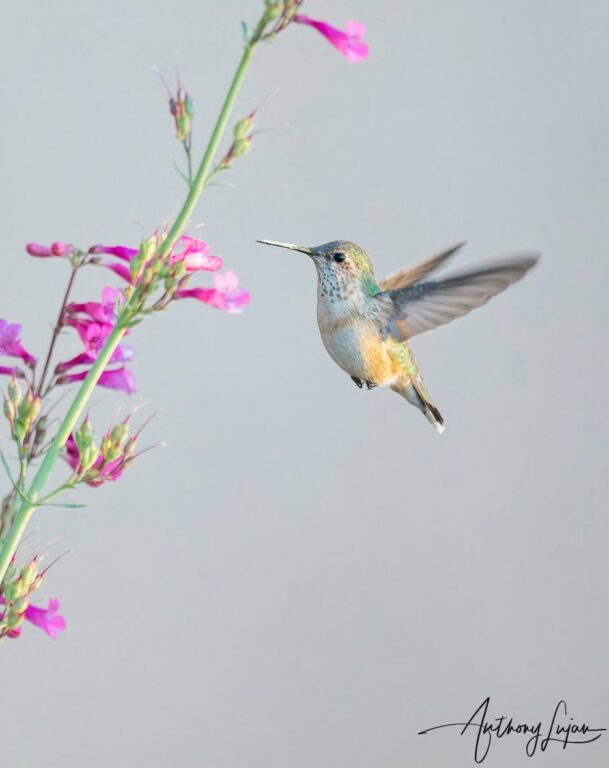
Photo by: Anthony Lujan
Juvenile Calliope hummingbirds, both male and female, look more like adult females until they are differentiated as the male begins to acquire the iridescent feathers that are typical of this species of hummingbird.

Photo by: sony_alpha_male
Note: His bright throat feathers are slowly coming in.
Baby Calliope hummingbirds are easily identified by their white fluffy feathers near their bottom that will disappear as they age.
Like many hummingbirds, Calliopes communicate not just by their song, but also by manipulating their feathers during flight to make different buzzing noises that act as a form of language and communication.
When a female is quietly perched, the male will passionately fly back and forth and engage in a “U” shaped courtship display to gain her attention. During his presentation, the male hummingbird will produce a vocal serenade while swinging his body from side to side in front of the female.
See my article: Hummingbird Dance: 5 Interpretive Explanations
Male Calliope hummingbirds establish a breeding territory and mate with every available female hummingbird that accepts his courtship.
They hybridize and readily crossbreed with other hummingbird species, such as the Costa’s hummingbird.
During nest construction, the female Calliope chooses the tops of pine cones as her building site. She will also dismantle nests from previous seasons and recycle them in her new nest along with stealing materials from the nests of other birds in order to construct her own.
Therefore, female Calliopes are often chased and attacked by larger and more aggressive hummingbirds such as Allen’s and Rufous hummingbirds. To avoid these attacks, the Calliope maintains a relatively low profile in comparison to other species.
Calliope hummingbirds are the smallest long-distance migratory bird in the world. Their migratory patterns mimic Rufous hummingbirds with spring migration. During northbound spring migration, they pass through the Pacific Flyways.
On their southbound journey in the fall, they pass through the Pacific and Rocky Mountain Flyways towards their wintering destination in Mexico.
See my article: Hummingbird Migration in Texas
Because Calliope hummingbirds have a more restricted wintering range than most hummingbirds, they are particularly vulnerable to habitat loss and natural disasters, such as climate change and wildfires.
During a capture and release banding operation in Idaho, the oldest living recorded female Calliope hummingbird was 8 years and 11 months old when she was captured twice, once in 2007 and again in 2014.
See my article: 3 Reasons Why Hummingbirds Are Banded
ALLEN’S HUMMINGBIRD – (Selasphorus sasin)
Conservation Status: Least concerned
Kingdom: Animalia
Phylum: Chordata
Class: Aves
Order: Apodiformes
Family: Trochilidae
Genus: Selasphorus
Species: S. sasin
The Allen’s hummingbird is one of the five year-round residents to Texas. The others include Broad-tailed, Berylline, Buff-bellied, and Calliope.
On average, out of 10,000 hummingbird sightings in Texas, 34 will be of the Allen’s hummingbird. Out of all hummingbird sightings in Texas, 0.3% will be Allen’s hummingbirds.
See Texas Allen’s sightings map
The common name of Allen’s hummingbird is in commemoration of Charles Andrew Allen (1841-1930), an American collector and taxidermist.
Male Allen’s hummingbirds are green-backed with a green forehead and rust-colored flanks, rump, and tail. When their tail feathers are fanned out you can see their chocolate-colored tips. The gorget of the male Allen’s hummingbird is an iridescent orange-red, however, in darker lighting, it can appear chocolate brown. Allen’s hummingbirds are 3.3 inches to 3.5 inches in length and weigh 2-4 grams.
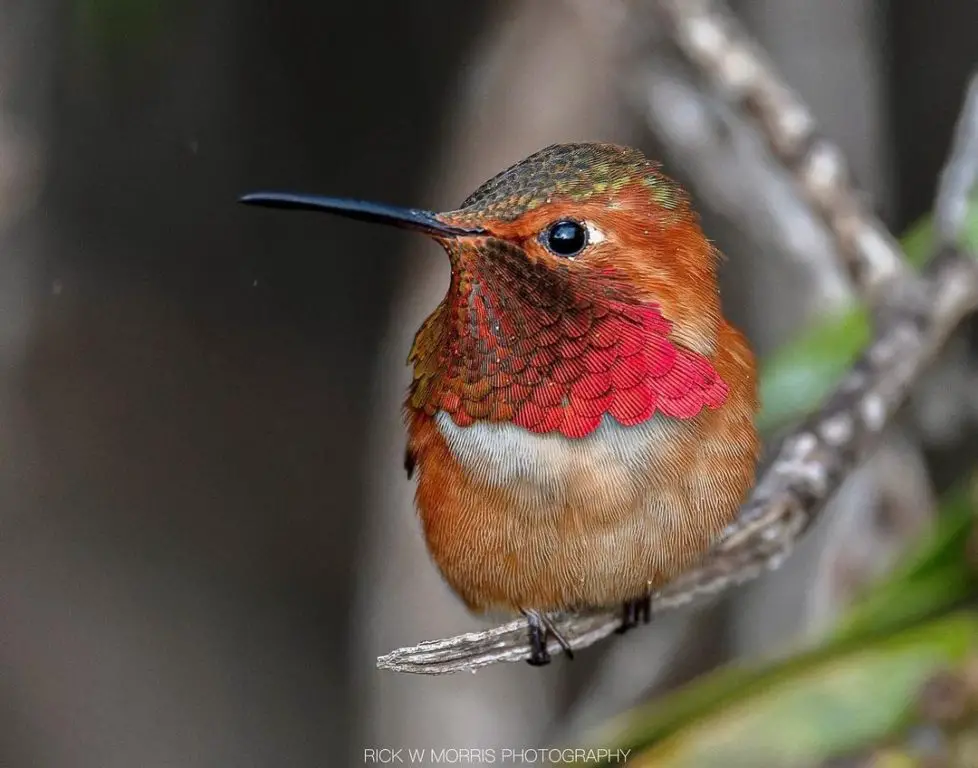
Photo by: IntheWildwithRick
Note: The iridescent orange-red gorget.

Photo by: IntheWildwithRick
Female Allen’s hummingbirds have similar coloring as the males but do not have a gorget or iridescent feathers making them less vibrant. However, some females can have stippling or specs of color near their throat line looking similar to a juvenile which can cause confusion out in the field.

Photo by: aarongomperts
See my article: Hummingbird Parents: (Mating to Nesting)
See my article: Baby Hummingbirds: (Egg to Fledgling)
Allen’s hummingbirds commonly reside and nest along the west coast and winter in Mexico. Their nesting season is perfectly timed with when the regions have the most rainfall which helps provide prolific nectar-producing flowers for their offspring.
Juvenile Allen’s hummingbirds, both male and female, look more like adult females until they are differentiated as the male begins to acquire the iridescent feathers that are typical of this species of hummingbird.

Note: This juvenile male Allen’s hummingbird is on a tomato cage defending a feeder.
Notice there are still white fluffy down feathers near his bottom as well as some stippling around his throat and not a full gorget has matured, suggesting he is not a full adult yet, however, is in the early stages of adolescence.
Juvenile Allen’s hummingbirds are so similar in coloring and temperament to a Rufous hummingbird that they are practically indistinguishable in the field. Therefore, identification is established by range rather than appearance.
Baby Allen’s hummingbirds are easily identified by their white fluffy feathers near their bottom that will disappear as they age.

Note: He is diligently defending a nearby feeder. Notice the difference in stages from the last photo on a tomato cage [an older juvenile] to the present photo on an outside light wire [young baby]. They both have white fluffy feathers near their bottom, however, you can clearly see an age difference from youth to maturity.

Note: On a tomato cage; hiding in a tomato plant near a feeder.
Male Allen’s hummingbirds perform a striking, quick back-and-forth courtship dance resembling the movement of a pendulum. They have one of the most complex territorial dive displays of any North American hummingbird.
See my article: Hummingbird Dance: 5 Interpretive Explanations
Male and female Allen’s hummingbirds are not social birds. They do not associate with one another outside of breeding. Similar to a Rufous hummingbird, Allen’s hummingbirds are highly territorial and aggressive towards other hummingbirds and larger predatory birds such as hawks.
During a capture and release banding operation in California, the oldest living recorded Allen’s hummingbird was 5 years and 11 months old when she was first captured in 2004 and again in 2009.
See my article: 3 Reasons Why Hummingbirds Are Banded
BERYLLINE HUMMINGBIRD – (Amazilia beryllina)
Conservation Status: Least concerned
Kingdom: Animalia
Phylum: Chordata
Class: Aves
Order: Apodiformes
Family: Trochilidae
Genus: Amazilia
Species: A. beryllina
The Berylline hummingbird is a very rare hummingbird seen in Texas but according to one of Google’s top-ranked websites, it is a year-round hummingbird in Texas.
On average, out of 425,000 hummingbirds, Texans will see only 1 Berylline hummingbird. Out of all hummingbird sightings in Texas, 0.001% will be Berylline hummingbirds.
See Texas Berylline sightings map
Berylline hummingbirds are primarily found in Mexico and Honduras, therefore are considered an extremely rare species in Texas. They were first documented in the United States in 1964.
Berylline (pronounced: berra-line) hummingbirds get their name from the Latin word beryllina meaning “green color” which stems from beryl, a colorless mineral. Known varieties of colored beryl are emerald and aquamarine gemstones that closely match the color of these birds.
Male Berylline hummingbirds are identified by their bright iridescent emerald green crown and gorget (head and throat feathers). Their underbelly is a brownish-beige hue. The wings are a dark rich brown with nutmeg accents and their forked tail is purplish red. Their size is 3.1 inches to 3.9 inches in length and are considered a medium-sized hummingbird. They weigh 4-5 grams.
Female Berylline hummingbirds are less vibrant than males and usually do not have iridescent feathers.
Juvenile Berylline hummingbirds, both male and female, look more like adult females until they are differentiated as the male begins to acquire the iridescent feathers that are typical of this species of hummingbird.
Baby Berylline hummingbirds are easily identified by their white fluffy feathers near their bottom that will disappear as they age.
Their breeding habitat resides in Central America in the lush tropical forests of western Mexico and Honduras. They prefer habitats that favor oak and pine from the woodlands along with tropical deciduous forests that provide heavy rainfall in the summers and dry winter topography.
Berylline hummingbirds are known to hybridize with the Rivoli’s aka Magnificent hummingbird, Azure-crowned hummingbird, and the Blue-tailed hummingbird.
See pictures and hear sounds of male, female, and juvenile Berylline hummingbirds
Seasonal Hummingbirds in Texas:
This hummingbird classification is defined as hummingbirds that temporarily pass through Texas as part of their migratory pattern during spring and fall migration.
Hummingbirds travel north to breed during spring migration and travel south during fall migration to winter in Mexico and Central America.
Some seasonal hummingbirds may remain in Texas for the entire winter by choice, injury, or old age.
The two hummingbirds in Texas that are the most commonly seen and classified as Seasonal:
- Ruby-throated
- Black-chinned
Below are the seasonal Texas hummingbird sightings listed from the most to the least seen.
RUBY-THROATED HUMMINGBIRD – (Archilochus colubris)
Conservation Status: Least concerned
Kingdom: Animalia
Phylum: Chordata
Class: Aves
Order: Apodiformes
Family: Trochilidae
Genus: Archilochus
Species: A. colubris
The Ruby-throated is the most commonly seen hummingbird in Texas.
Ruby-throated hummingbirds over-winter in Texas but are noticeably absent in June and July as they migrate further north during these two months placing them in the seasonal and not annual category.
On average, out of 10,000 hummingbirds, Texans will see 4,015 Ruby-throated hummingbirds. Out of all hummingbird sightings in Texas, 40% will be Ruby-throated hummingbirds.
See Texas Ruby-throated sightings map
The Ruby-throated hummingbird’s scientific name originated from Carl Linnaeus, a Swedish botanist, who first listed this scientific classification as “Trochilus colubris”. Its name changed over a hundred years later and was reclassified by Ludwig Reichenbach, a German botanist, to “Archilochus colubris”, which is its current scientific name, meaning “top thief” or “sky spirit/sun-god bird”.
Male Ruby-throated hummingbirds have a striking iridescent blood-red gorget, stopping at the neckline. He is identified with a dull metallic green topside, a light gray underbelly, and black wings. The Ruby-throated hummingbird is a smaller species of hummingbird weighing less than 4.5 grams or 2 U.S. dimes and is 2.8 to 3.3 inches in length. Their lifespan is approximately 3-5 years.
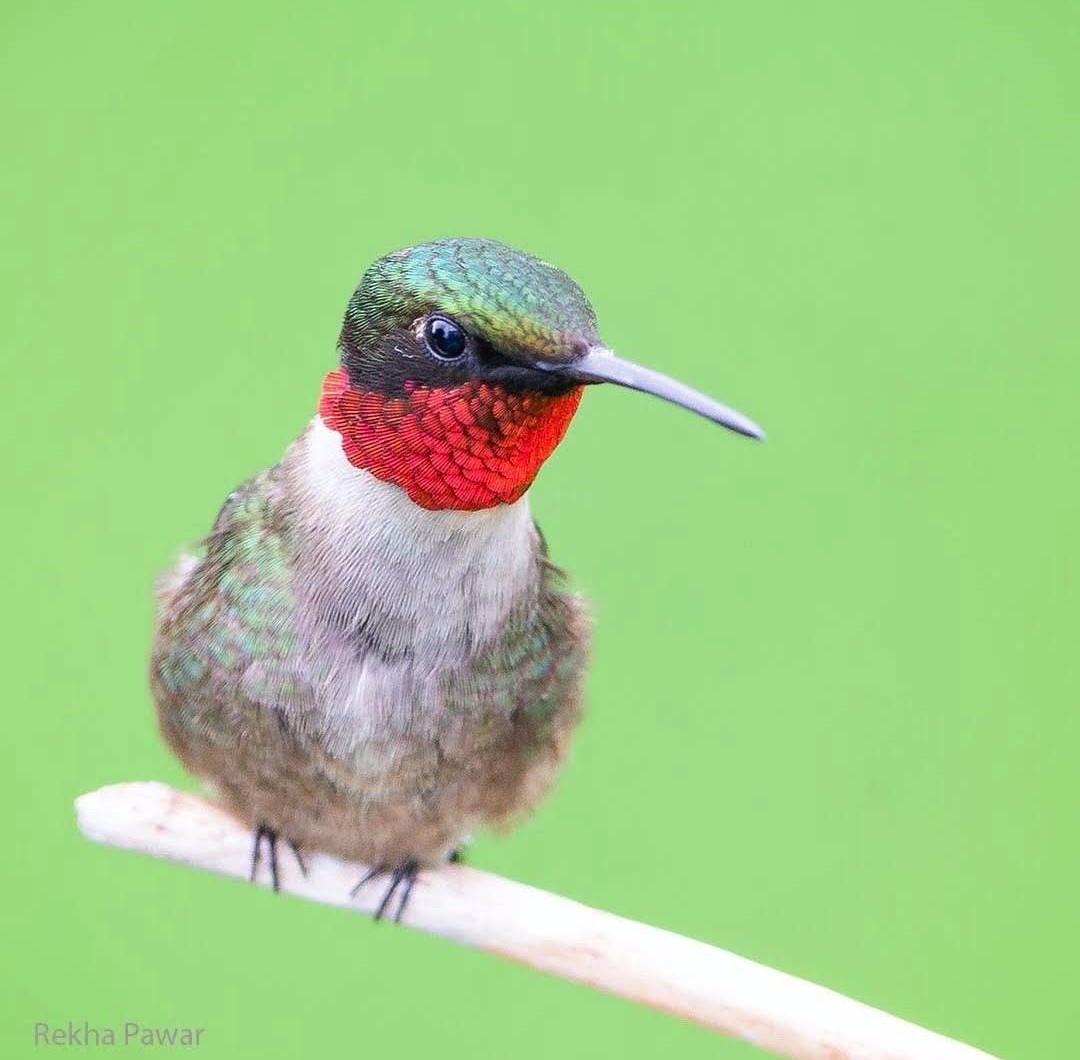
Photo by: Rekha Pawar

Photo by: Rekha Pawar
Female Ruby-throated hummingbirds have a white throat with some light stippling and are typically larger than the males. The oldest female Ruby-throated hummingbird has been recorded at 9 years, almost double that of the male.

Photo by: Dgen.photos

Photo by: paulapaintsart
However, the average lifespan of a Ruby-throated hummingbird is approximately 3-5 years.
Juvenile male and female Ruby-throated hummingbirds during their initial stages of life resemble their mother exhibiting a white throat with light stippling.
As the males mature, they begin to display a few specks of color near their neckline and eventually their bolder red throat feathers become more dominant and stately displaying a colorful gorget.

Photo by: Dgen.photos
Note: His throat feathers are slowly coming in, displaying a few dots of color near his neckline and showing the first stages of adolescence.

Photo by: MaryLou Ziebarth
Note: This juvenile Ruby-throated hummingbird is struggling with a bee or wasp situation at the feeder.
See my article: Bees On My Hummingbird Feeder: (9 Tips To Get Rid of Them)
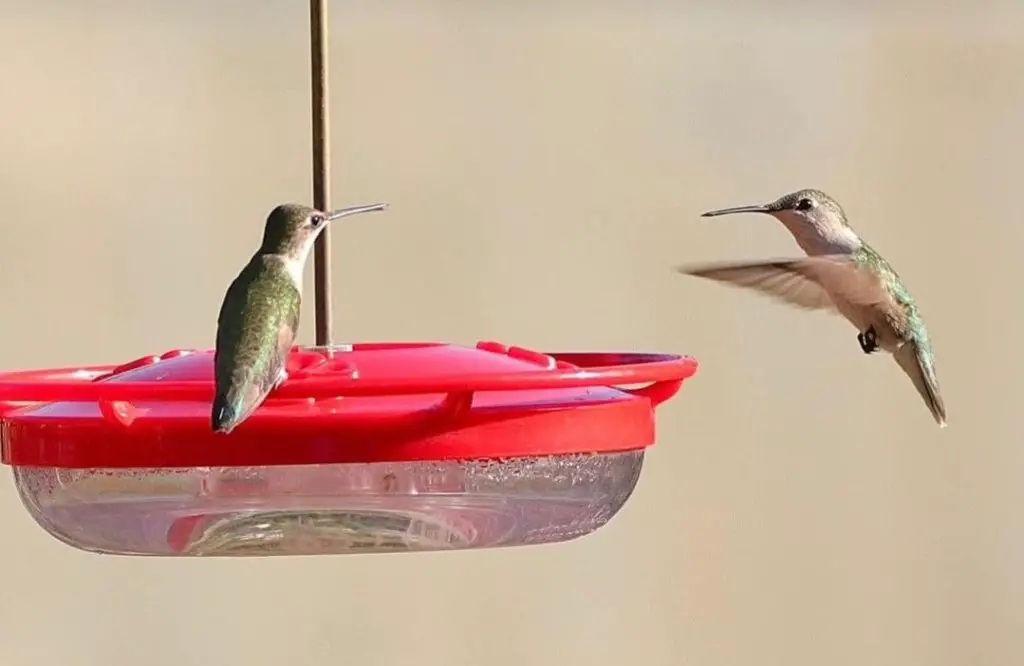
Photo by: Dgen.photos
Note: These two juvenile Ruby-throated hummingbirds are playing nice and sharing a feeder. This could be because they are siblings or just getting the courage to find food on their own.
Baby Ruby-throated hummingbirds are easily identified by their white fluffy feathers near their bottom that will disappear as they age.

Photo by: Rekha Pawar

Photo by: MaryLou Ziebarth
Note: The newly white fluffy down feathers on both of these baby Ruby-throated hummingbird’s bottoms. Also, notice the nice fat reserves they have accumulated by being fed by their diligent mother which will sustain them through adolescence.
There are two migration routes for the Ruby-throated hummingbird during the spring and fall migrations.
The first migration route is a direct but exhausting nonstop journey southwest over the Gulf of Mexico to Mexico and then down to Central America for the winter. The flight distance over the Gulf of Mexico is over 500 miles. Although this is the direct “short” route, there are numerous obstacles faced by these birds.
Some obstacles include not being able to rest, having no means to refuel or eat, and having to avoid the dangerous tropical Atlantic hurricanes while flying to their destination. To make matters worse, depending on how you look at it, they migrate during the dark hours of the night or are taking the “Red-eye flight”.
Researchers believe their small size makes the energy expenditure of their grueling trans-oceanic migration pattern more taxing for males than for females even though they both double their body’s fat prior to making the migration across the Gulf of Mexico.
The second migration route is over 2,000 miles, flying along the coastline outlining the Gulf of Mexico. Although this is the “long” route, it allows the opportunity to rest and refuel even though there are fewer food source guarantees along the way.
Scientists are unclear and continue to investigate why one group of birds would prefer to take one route over the other.
See my article: Hummingbird Migration in Texas
Hummingbirds are much more tolerant of cold temperatures than most people realize.
According to eBird.org, through branding practices in Wisconsin, the Ruby-throated and Rufous hummingbirds have been documented surviving in temperatures of -9F and wind chills of -36F.
See my article: 3 Reasons Why Hummingbirds Are Banded
This selfless act also provides nectar to other migrating species unable to migrate because of injury or old age.
See my article: 11 DIY Ways to Keep Hummingbird Nectar From Freezing
Ruby-throated hummingbirds prefer open woodlands and are often seen in parks, gardens, and backyards. They are solitary birds except during mating periods when they are fiercely territorial and aggressive towards hummingbirds of other species.
Even though these hummingbirds have an aggressive side they can still be eaten by predators such as large invertebrates, praying mantises, orb-weaver spiders, and dragonflies.
See my article: 10 Common Things That Kill Hummingbirds
During a capture and release banding operation in West Virginia, the oldest living recorded female Ruby-throated hummingbird was 9 years and 1 month old.
See my article: 3 Reasons Why Hummingbirds Are Banded
BLACK-CHINNED HUMMINGBIRD – (Archilochus alexandri)
Conservation Status: Least concerned
Kingdom: Animalia
Phylum: Chordata
Class: Aves
Order: Apodiformes
Family: Trochilidae
Genus: Archilochus
Species: A. alexandri
Black-chinned hummingbirds are a migrating species and are seen mainly in the Western United States. They are the second most commonly seen hummingbird in Texas, especially during the hot summer months.
They begin migrating south for the winter towards Mexico from the middle of July to the middle of October.
According to the National U.S Parks Service of Chamizal, Black-chinned hummingbirds migrate through El Paseo from April to September.
On average, out of 10,000 hummingbird sightings in Texas, 3,368 will be of the Black-chinned hummingbird. Out of all hummingbird sightings in Texas, 33% will be Black-chinned hummingbirds.
See Texas Black-chinned sightings map
Black-chinned hummingbird’s scientific name is in commemoration of Dr. Alexandre, a French doctor who was the first to discover the species in Mexico.
Male Black-chinned hummingbirds are identified by their royal purple gorget, showing a small glimmer of color right near the neckline like a buttoned-up shirt. Since the male purple gorget or throat color is minimal, at times they can appear to look all black. They have metallic green on their backs and flanks with white on their underbelly. Their dark tail is forked and their bill is black. Their size is 3.25 inches to 3.5 inches in length and weighs 2.8-5.6 grams.

Photo by: sony_alpha_male

Photo by: hummingbirdsbysuprise

Photo by: bird.whisperer
Female Black-chinned hummingbirds do not have a gorget or iridescent feathers and are less vibrant than the males. They have a white underbelly and a dark rounded tail with white tips and beige margins on the dorsal feathers that turn dark black as they mature. Their head and back reflect the dull metallic marbled colors of beige, greens, whites, yellow-green, and dark browns, looking similar to the scales found on a snake.
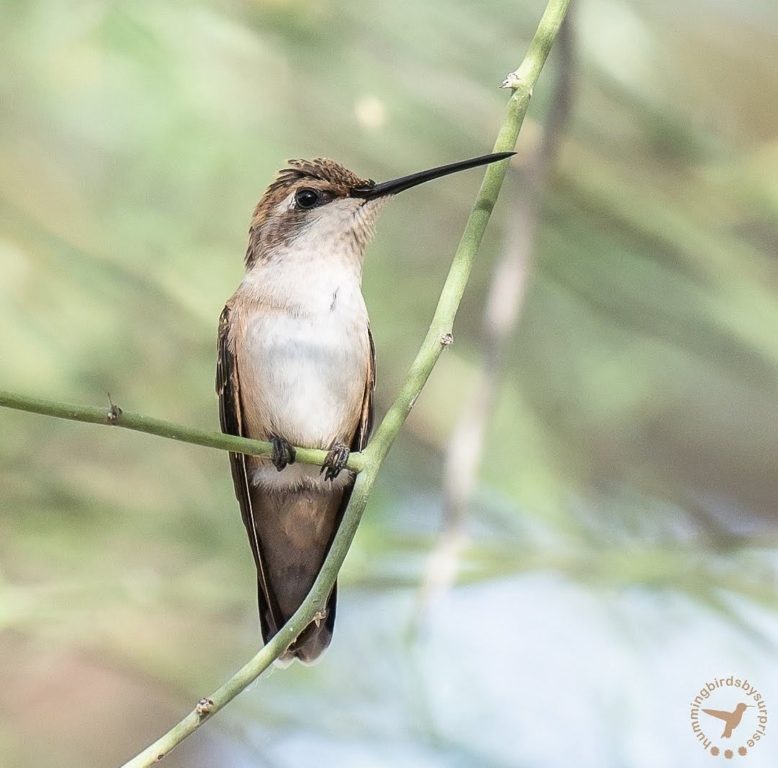
Photo by: hummingbirdsbysuprise
Black-chinned hummingbirds breed east of the Cascade mountain range. They are known to make their nests near larger more active bird nests, reducing the chance of predators around the nest by using a decoy strategy.
Their breeding grounds and habitat are closely related to the Ruby-throated hummingbird.
Juvenile Black-chinned hummingbirds, both male and female, look more like adult females until they are differentiated as the male begins to acquire the iridescent feathers that are typical of this species of hummingbird.
Baby Black-chinned hummingbirds are easily identified by their white fluffy feathers near their bottom that will disappear as they age.
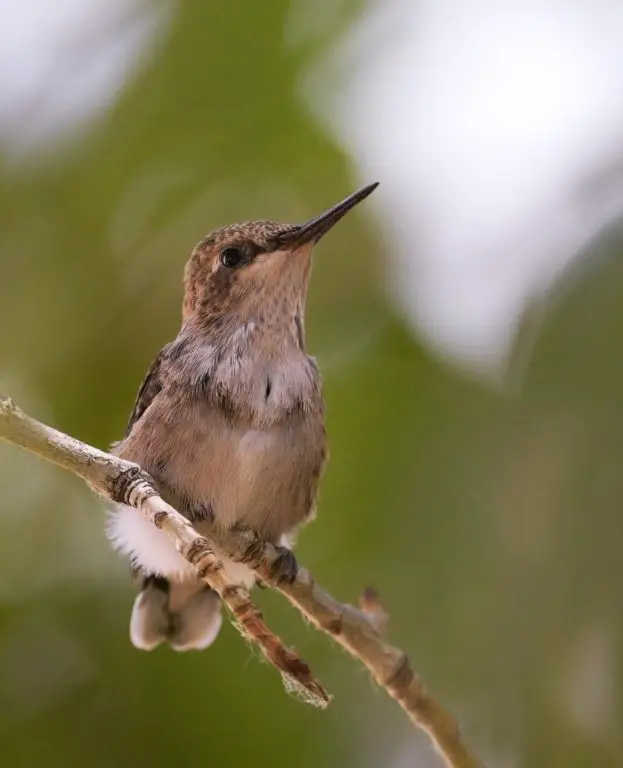
Photo by: bird.whisperer
Black-chinned hummingbirds have the smallest known genetic material of all living vertebrates or mammals. Because of their small size, they are at risk of being preyed upon by larger insect-eating birds.
See my article: 10 Common Things That Kill Hummingbirds
Hummingbirds are extremely territorial and can come across as being the meanest sheriff in town, especially when defending “their” feeders. They will fight over territory to protect nectar sources full of hummingbird-friendly flowering plants.

Photo by: hummingbirdsbysuprise
See my article: Why Hummingbirds Chase Each Other: Is it Friend or Foe?
While typically a territorial species, if Black-chinned hummingbirds find themselves in an area with a large population of hummingbirds and food sources, their territorial behavior reduces, and they will play nice and share.
They hybridize and readily crossbreed with other hummingbird species, such as the Anna’s and Costa’s hummingbirds. Black-chinned hummingbirds can live up to 10 years, which is extremely long in comparison to other birds and animals of similar size.
During a capture and release banding operation in Texas, the oldest living recorded female Black-chinned hummingbird was 11 years and 2 months old.
See my article: 3 Reasons Why Hummingbirds Are Banded
Rare/Vagrant Hummingbirds in Texas:
This hummingbird classification is defined as hummingbirds residing in a group outside of their normal geographic range. Not only do these species of hummingbirds have a wide variety of specific geographic ranges, but they are also known to sometimes interbreed with each other creating hybrids.
These hummingbirds are out of their normal area of occupancy but have been documented as being seen in Texas.
There are thirteen hummingbirds seen in Texas that are classified as Rare/Vagrants:
- Rufous
- Anna’s
- Lucifer
- Blue-throated
- Broad-billed
- Rivoli’s
- Mexican-Violetear
- Green-breasted
- Costa’s
- Violet-crowned
- White-eared
- Amethyst-throated
- Cinnamon
Below are the Rare/Vagrant Texas hummingbird sightings listed from the most to the least seen.
RUFOUS HUMMINGBIRD – (Selasphorus rufus)
Conservation Status: Near threatened
Kingdom: Animalia
Phylum: Chordata
Class: Aves
Order: Apodiformes
Family: Trochilidae
Genus: Selasphorus
Species: S. rufous
Rufous hummingbirds are migratory birds and are seen in Texas. On average, out of 10,000 hummingbird sightings in Texas, 664 will be of the Rufous hummingbird. Out of all hummingbird sightings in Texas, 6.6% will be Rufous hummingbirds.
See Texas Rufous sightings map
The Rufous hummingbird gets its name from the Latin word rubrum meaning “red” which is used to describe its reddish-brown coloring.
Male Rufous hummingbirds display an iridescent orange-red gorget with rusty-colored flanks and tail. They have a white-to-beige underbelly and a black bill. Males can also have green plumage with specks of green color on their rustic-looking backs or on the crown of their head along with chocolate brown dorsal feathers. Their size is 2.8 inches to 3.5 inches in length and weighs 3.2 grams.


Photo by: Kevin Walsh
Note: The iridescent orange-red gorget.

Photo by: Kevin Walsh
Note: The gorget appears chocolate brown in this lighting, however, you can still see a glimmer of his iridescent orange-red gorget with some hints of yellow.
Female Rufous hummingbirds have similar coloring as the males but do not have a gorget or iridescent feathers making them less vibrant. However, some females can have stippling or specs of color near their throat line looking similar to a juvenile which can cause confusion out in the field.
They are slightly larger than the males in anticipation of producing offspring.

Photo by: Kevin Walsh
They have one of the northernmost breeding ranges of any hummingbird in the world; migrating north from Mexico and nesting as far north as Alaska to breed during the summer months.
They are polygamous and will mate with several partners in a season.
See my article: Hummingbird Parents: (Mating to Nesting)
See my article: Baby Hummingbirds: (Egg to Fledgling)
Juvenile Rufous hummingbirds are so similar in coloring and temperament to Allen’s hummingbirds that they are practically indistinguishable in the field. Therefore, identification is established by range rather than appearance.
Juvenile male Rufous hummingbirds have a rustic look with small iridescent orange specks of color on their throats.
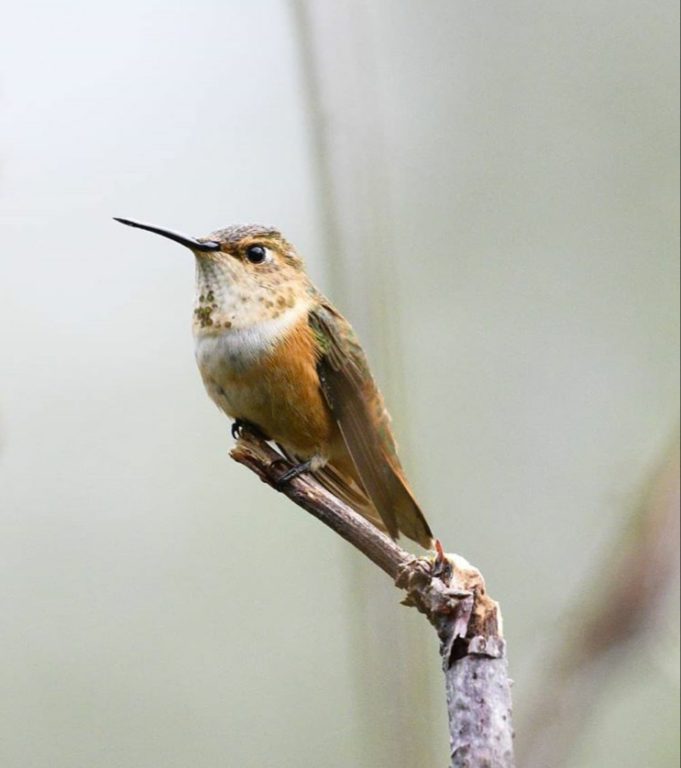
Photo by: Jace_the_bird_nerd

Photo by: Rekha Pawar
Note: His throat feathers are slowly coming in, displaying a few dots of color near his neckline and showing the first stages of adolescence.

Photo by: Rekha Pawar
Note: Preening flight feathers is an important daily routine to maintain hygiene and to keep the feathers flexible, strong, in alignment, and parasite-free.
Baby Rufous hummingbirds are easily identified by their white fluffy feathers near their bottom that will disappear as they age.
Rufous hummingbirds make the longest migration of any bird in the world. They travel making a clockwise circuit of western America every year that is approximately 3,900 miles.
This migratory pattern during the seasons coordinates their arrival perfectly while catching nectar and blooming flowers throughout the year, fueling their bodies for their long journey.
Hummingbird enthusiasts are extremely valuable when they plant flowering plants to attract hummingbirds and provide feeders with homemade hummingbird nectar to contribute to a successful migration. These welcoming habitats provide and ensure safe travels as well as a reliable sanctuary for rest and refueling during their journey.
Rufous hummingbirds are highly territorial and aggressive towards other hummingbirds and animals. They are fearless and have a reputation for being feisty and chasing away not only other hummingbirds but even large birds and rodents from their favorite feeders.
The female mothers have been known to even attack squirrels and chipmunks that come too close to their nest.
Rufous hummingbirds have excellent memories and have been known to investigate the location of an old hummingbird feeder years after the feeder has been removed.
Their flying acrobatic skills can outmaneuver all other hummingbird species, making them extremely competitive at feeders.
Rufous hummingbirds hybridize and readily crossbreed with other hummingbird species, such as the Anna’s hummingbird.
Due to habitat loss in the Pacific Northwest, Rufous hummingbirds are listed at “near threatened” status by the IUCN red list of threatened species.
During a capture and release banding operation in British Columbia, the oldest living recorded female Rufous hummingbird was 8 years and 11 months.
See my article: 3 Reasons Why Hummingbirds Are Banded
ANNA’S HUMMINGBIRD – (Calypte anna)
Conservation Status: Least concerned
Kingdom: Animalia
Phylum: Chordata
Class: Aves
Order: Apodiformes
Family: Trochilidae
Genus: Calypte
Species: C. anna
Anna’s hummingbirds are predominately a west coast bird found all along the California, Oregon, and Washington coasts and all the way up to Alaska and Canada making them rare in Texas.
On average, out of 10,000 hummingbird sightings in Texas, 91 will be of the Anna’s hummingbird. Out of all hummingbird sightings in Texas, 0.9% will be Anna’s hummingbirds.
See Texas Anna’s sightings map
Anna’s hummingbirds are named after Anna Massena, Duchess of Rivoli. They are the only hummingbirds to stay year-round on the Pacific Coast. These hummingbirds live in a Mediterranean climate with moderate wet winters and hot dry summers.
Male Anna’s hummingbirds are the only hummingbird species in North America with a red crown. They are identified as mostly green, gray, and magenta in color. The males have a flashy and colorful iridescent magenta gorget and crown. Their size ranges from3.5 inches to 4.3 inches in length and they weigh 2.4 to 4.5 grams.
The gorget on a male hummingbird is named after the protective metal piece in a suit of armor that covers the wearer’s throat to prevent injury when in battle. Since male hummingbirds are very aggressive with each other when fighting for their own territory, this name is appropriate and fitting to describe their physical attributes.

Photo by: Kevin Walsh
Note: The iridescent magenta gorget and crown with a metallic green shiny back.

Photo by: IntheWildwithRick
Female Anna’s hummingbirds are overall not as colorful as the males, appearing pale green in color. Females can also have a gorget, but it is a smaller patch of magenta. Females tend to have a pale white line over each eye that makes them distinctive.

Photo by: IntheWildwithRick

Photo by: Kevin Walsh
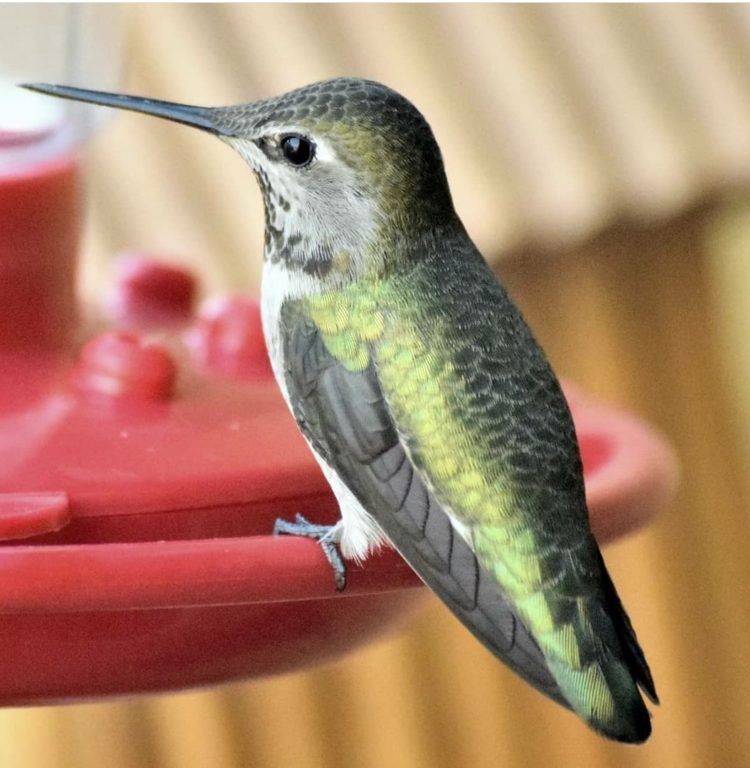
Photo by: Mehta.vishal.360

Photo by: Mehta.vishal.360
Female Anna’s hummingbirds raise their young with no help from the males.
See my article: Hummingbird Parents: (Mating to Nesting)
See my article: Baby Hummingbirds: (Egg to Fledgling)
Juvenile Anna’s hummingbirds, both male and female, look more like adult females until they are differentiated as the male begins to acquire the bright red/magenta gorget.
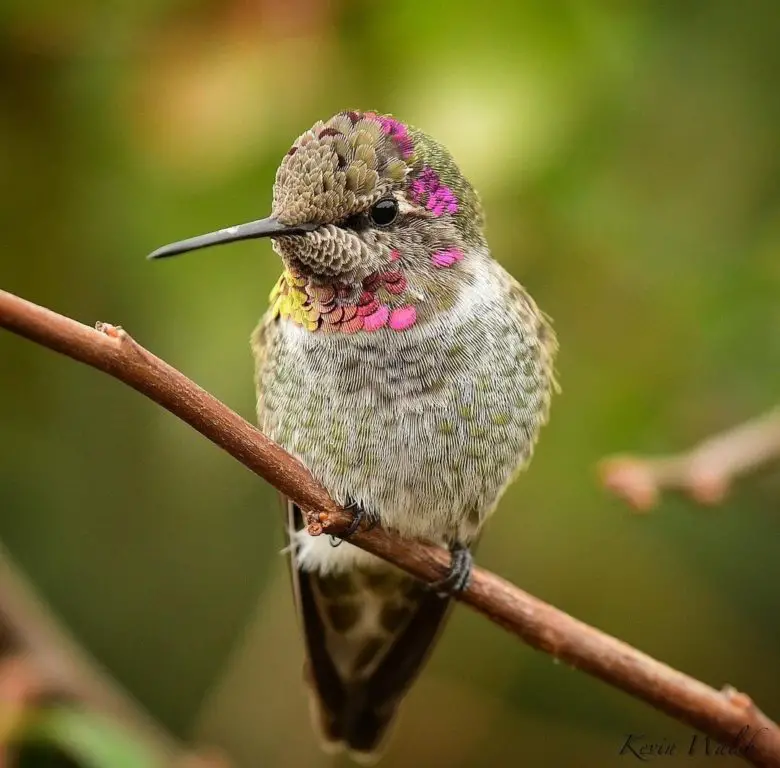
Photo by: Kevin Walsh
Note: This Anna’s hummingbird could be a juvenile in those awkward teenage years or it could be during a molting stage.
Baby Anna’s hummingbirds are easily identified by their white fluffy feathers near their bottom that will disappear as they age.

Photo by: Kevin Walsh
Note: This baby/juvenile male Anna’s hummingbird is beginning to show his magenta head feathers near his temple along with some faint color starting to show on his gorget. Also, notice the newly white fluffy down feathers near his bottom as well as the nice fat reserves he has accumulated by being fed by his diligent mother.

Photo by: Kevin Walsh
The courtship and dive displays performed by Anna’s hummingbirds are theatrical and entertaining. From the beginning to the end, the full dive display lasts 12 seconds.
See my article: Hummingbird Dance: 5 Interpretive Explanations
Unlike many northern temperate hummingbirds, male Anna’s hummingbirds sing during courtship along with making vibrations with their tail feathers to attract a female.
Anna’s hummingbirds protect their territory with elaborate dives targeted towards predatory birds and even towards people they perceive to be threatening.
They hybridize and readily crossbreed with other hummingbird species, such as the Black-chinned, Costa’s, and Rufous hummingbirds.
During a capture and release banding operation in Arizona, the oldest living recorded male Anna’s hummingbird was 8 years and 2 months.
See my article: 3 Reasons Why Hummingbirds Are Banded
LUCIFER HUMMINGBIRD – (Calothorax lucifer)
Conservation Status: Least concerned
Kingdom: Animalia
Phylum: Chordata
Class: Aves
Order: Apodiformes
Family: Trochilidae
Genus: Calothorax
Species: C. lucifer
The Lucifer hummingbird is native to Mexico, however, Texas A&M states their range just reaches Texas, Arizona, and New Mexico.
On average, out of 10,000 hummingbirds, Texans will see only 72 Lucifer hummingbirds. Out of all hummingbird sightings in Texas, 0.7% will be Lucifer hummingbirds.
See Texas Lucifer sightings map
They are found in Big Bend National Park and also in the Davis Mountains in western Texas. Big Bend National Park is nestled in the south western area of Texas, very close to the Mexican border. To provide visual context, the distance between Big Bend National Park to the Davis Mountains is 127.2 miles or 2 hrs and 21 min driving.
The Lucifer hummingbird gets its name from the Latin word “Lucifer” referring to the morning star of the planet Venus or luminous light. The correlation is referring or describing the male’s iridescent gorget.
Male Lucifer hummingbirds have an iridescent royal purple gorget flaring down on both sides of the throat. They have a white breast, green crown, and back, with a slightly curved black bill. Their tails are deeply forked and are only visible when their tail feathers are flared or wide when maneuvering flight. Their size is 3.5 inches in length and weighs 3-4 grams.
Female Lucifer hummingbirds have a lighter gray/green crown and back with a cinnamon-buffy underbelly. Their dorsal wings are dark chocolate. They sport a small smudge of brown below their eyes. Their tails are shorter than the males.
In Texas, the nesting season of the Lucifer hummingbird ranges from early to mid-April; when food supplies are bountiful; to the beginning of July and can even last into early August.
Juvenile Lucifer hummingbirds, both male and female, look more like adult females until they are differentiated as the male begins to acquire the iridescent feathers that are typical of this species of hummingbird.
Baby Lucifer hummingbirds are easily identified by their white fluffy feathers near their bottom that will disappear as they age.
Lucifer hummingbirds are most adaptable to desert regions in Texas where their nests are located on Cane Cholla (a type of cactus), Ocotillo (looks like a cactus, but not a true cactus) and Agave lechugilla “stalks” (succulent plant ) that grow 2-15 feet above the ground. These plants have height and strength in their bendable/flexible stalks that grow high above the ground. This makes a unique and perfect location to build a nest safe and inconspicuous from predators.
During a capture and release banding operation in Texas, the oldest living recorded male Lucifer hummingbird was 7 years and 5 months.
See my article: 3 Reasons Why Hummingbirds Are Banded
See pictures of male, female and juvenile Lucifer hummingbirds
Hear the sounds of Lucifer hummingbirds
BLUE-THROATED MOUNTAIN-GEM HUMMINGBIRD aka BLUE-THROATED HUMMINGBIRD – (Lampornis clemenciae)
Conservation Status: Least concerned
Kingdom: Animalia
Phylum: Chordata
Class: Aves
Order: Apodiformes
Family: Trochilidae
Genus: Lampornis
Species: L. clemenciae
The Blue-throated Mountain-gem hummingbird aka Blue-throated hummingbird is a Mexican species and a rare visitor to Texas.
On average, out of 10,000 hummingbirds, Texas will see only 36 Blue-throated Mountain-gem hummingbirds. Out of all hummingbird sightings in Texas, 0.3% will be Blue-throated Mountain-gem hummingbirds.
See Texas Blue-throated Mountain-gem sightings map
The best way to discover and locate Blue-throated Mountain-gem hummingbirds is to visit the “sky island” mountain ranges of southeastern Arizona or the Chisos Mountains of Texas.
Male Blue-throated Mountain-gem hummingbirds feature a bright iridescent cobalt blue gorget and dramatic white stripes over both of its eyes. His wings and tail are dark with the tips of his tail painted white. Blue-throated Mountain-gem hummingbirds expose a dull greenish-gray color all over its body emphasizing more patches of a grayish-emerald green on their head, neck, and the top part of the shoulder where the wing attaches. Their size is 4.3 inches to 4.7 inches in length and weighs 8.1-8.6 grams.

Photo by: rekhakpawar

Photo by: rekhakpawar
Female Blue-throated Mountain-gem hummingbirds usually are more drab-looking than the males and usually do not have iridescent and distinctive blue throat feathers. They have a double white stripe on their face with gray underparts.
Juvenile Blue-throated Mountain-gem hummingbirds, both male and female, look more like adult females until they are differentiated as the male begins to acquire the iridescent feathers that are typical of this species of hummingbird.
Baby Blue-throated Mountain-gem hummingbirds are easily identified by their white fluffy feathers near their bottom that will disappear as they age.
According to The Cornell Lab, Blue-throated Mountain-gem hummingbirds are 3x heavier than the Ruby-throated hummingbird. This species is the largest hummingbird species to nest in the United States.
Partially because of their large size, Blue-throated Mountain-gem hummingbirds have the slowest recorded wingbeat rate of any known hummingbird. It takes a lot longer and more effort for a hummingbird with an extended wingspan to flap its wings in a figure-eight motion than it does for a smaller, more petite hummingbird.
Think of it visually on a larger scale between a Bald eagle’s wingspan ranging between 5.9-7.5 feet in length and a crow ranging between 2.8-3.3 feet in length. It takes more effort to be in motion for one over the other.
Most North American hummingbirds have a courtship dance to entice a female and catch her attention before mating. Male Blue-throated Mountain-gem hummingbirds are an exception to the rule and do not show an aerial display. However, the females make an identifiable call and a sequence of short flights to the male signaling he has been chosen and she is ready for copulation.
Blue-throated Mountain-gem hummingbirds are mountainous birds that prefer to nest on rock overhangs or on human residential structures. They are known to return to the same nest each year, stacking new nests on top of old nests until they resemble a tall tower.
Blue-throated Mountain-gem hummingbirds become aggressive and territorial over flower types with a higher sugar content and will violently defend them from invaders, which is typical for most hummingbirds. They are heavily insectivorous due to the energy necessities of their size, and as a result, eat more insects than any other hummingbird species.
They hybridize with other hummingbird species holding little to no judgment on choosing a larger species, such as the Rivoli’s aka Magnificent hummingbird or a smaller species, the Anna’s, Black-chinned, and Costa’s hummingbirds with which to procreate.
During a capture and release banding operation in Arizona, the oldest living recorded male Blue-throated Mountain-gem hummingbird was 7 years and 11 months.
See my article: 3 Reasons Why Hummingbirds Are Banded
See pictures of the male, female, and juvenile Blue-throated Mountain-gem hummingbirds
Hear the sounds of the Blue-throated Mountain-gem hummingbirds
BROAD-BILLED HUMMINGBIRD – (Cynanthus latirostris)
Conservation Status: Least concerned
Kingdom: Animalia
Phylum: Chordata
Class: Aves
Order: Apodiformes
Family: Trochilidae
Genus: Cynanthus
Species: C. latirostris
Broad-billed hummingbirds are a Mexican species and a rare visitor to
Texas. They do travel frequently to the United States near the southern Mexican border, however, most of their population stays year-round in Mexico and Central America.
On average, out of 10,000 hummingbird sightings in Texas, 22 will be of the Broad-billed hummingbird. Out of all hummingbird sightings in Texas 0.2% will be Broad-billed hummingbirds.
See Texas Broad-billed sightings map
Male Broad-billed hummingbirds feature a bright blue-green gorget that spreads back toward its shoulders. Juvenile males show off a full charcoal dark gray body with flecks of metallic blue on their throat and a light green neck and backside. They sport a long beak that is bright orange-red accented with a signature black tip. Their size ranges from 3.25 inches to 4 inches in length and weighs 3-4 grams.

Photo by: hummingbirdsbysuprise
Female Broad-billed hummingbirds usually are more drab-looking than the males and usually do not have iridescent feathers. They have a completely dark bill and a longer white accent above the eyes. They are identified as having a predominantly metallic green topside with a white underbelly. Their tails are dark in color and forked.
Broad-billed hummingbird nests are distinguishable because they do not decorate the outside of their nests with lichens but instead choose to construct their nests with outside grass fibers, bits of leaves, and bark while using spider webs to glue and hold the nest together. The nest the female builds hangs on a single long slender branch.
Juvenile Broad-billed hummingbirds, both male and female, look more like adult females until they are differentiated as the male begins to acquire the iridescent feathers that are typical of this species of hummingbird.

Photo by: Aaron Gomperts
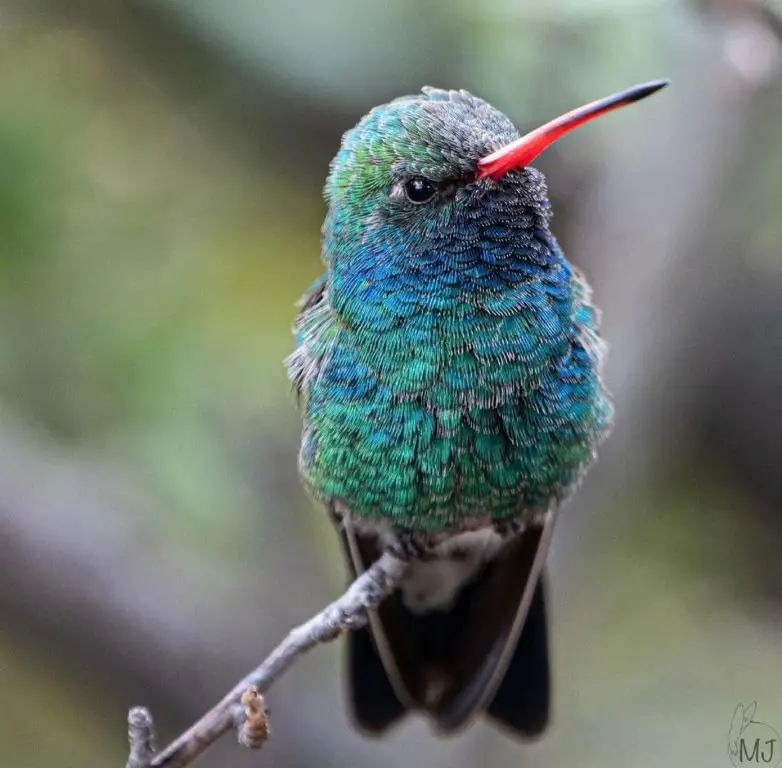
Photo by: hummingbirdsbysuprise
Baby Broad-billed hummingbirds are easily identified by their white fluffy feathers near their bottom that will disappear as they age.
Hummingbirds are extremely territorial and can come across as being the meanest sheriff in town, especially when defending “their” feeders. They will fight over territory to protect nectar sources full of hummingbird-friendly flowering plants.

Photo by: hummingbirdsbysuprise
See my article: Why Hummingbirds Chase Each Other: Is it Friend or Foe?
Astonishingly, unlike other hummingbird population counts, the Broad-billed hummingbird has shown an actual general population increase in recent years.
In Arizona, the oldest recorded male Broad-billed hummingbird was 9 years and 1 month old when he was captured and released from a banding operation.
See my article: 3 Reasons Why Hummingbirds Are Banded
RIVOLI’S HUMMINGBIRD aka MAGNIFICENT – (Eugenes fulgens)
Conservation Status: Least concerned
Kingdom: Animalia
Phylum: Chordata
Class: Aves
Order: Apodiformes
Family: Trochilidae
Genus: Eugenes
Species: E. fulgens
Rivoli’s hummingbirds are predominantly found in Mexico, Guatemala, and Nicaragua, therefore they are considered rare in Texas.
On average, out of 10,000 hummingbird sightings, only 20 will be Rivoli’s hummingbirds. Out of all hummingbird sightings in Texas 0.2% will be Rivoli’s hummingbirds.
See Texas Rivoli’s sightings map
Although they do travel frequently to the United States near the southern Mexican border, most of their population stays year-round in Mexico and Central America.
The Rivoli’s hummingbird (pronounced: rivo-lee) aka the “Magnificent” hummingbird has undergone several name changes. It was changed to the “Magnificent” hummingbird in 1983 then to “Refulgent” hummingbird only to have the “Rivoli’s” hummingbird name return in 2017 when the species was split into two variations (Rivoli’s and Talamanca). Rivoli’s hummingbird is named in honor of Francois Victor Massena, the Duke of Rivoli, by the ornithologist Rene-Primevera Lesson.
Male Rivoli’s hummingbirds are somewhat dark in color except when they are shown in bright daylight, where their violet crown, bright blue-green gorget, and white eyespots are more apparent through iridescence. They are 4.3 to 5.5 inches in length and weigh 6-10 grams.
They are considered the second largest hummingbird in the United States, behind the Blue-throated Mountain-gem which is the largest.

Photo by: thehummingbirdguy
Female Rivoli’s hummingbirds are slightly duller in color than the males showing a bronzy green topside and dull gray underbellies with bright white eye accents.

Photo by: Hummingbirdsbysuprise
Juvenile Rivoli’s hummingbirds, both male and female, look more like adult females until they are differentiated as the male begins to acquire the violet crown, bright blue-green gorget, and white eyespots that are typical of this species of hummingbird.

Photo by: thehummingbirdguy
Note: He still displays some white fluffy feathers near his bottom from when he was a baby suggesting he is not a full adult, however, is in the later stages of adolescence.
Baby Rivoli’s hummingbirds are easily identified by their white fluffy feathers near their bottom that will disappear as they age.
They prefer to live in ravines while feeding in open meadows and will nest in trees overhanging streams and creeks. Their breeding habitat consists of building nests in evergreen coniferous trees such as pine, fir, and juniper.
Rivoli’s hummingbirds hybridize with other species of hummingbirds, even though it is rare, with Berylline, Broad-billed, Blue-throated Mountain-gem, and Violet-crowned hummingbirds.
During a capture and release banding operation in Arizona, the oldest living recorded male Rivoli’s hummingbird was 11 years and 2 months.
See my article: 3 Reasons Why Hummingbirds Are Banded
MEXICAN VIOLETEAR (aka GREEN VIOLETEAR) HUMMINGBIRD – (Colibri thalassinus)
Conservation Status: Least concerned
Kingdom: Animalia
Phylum: Chordata
Class: Aves
Order: Apodiformes
Family: Trochilidae
Genus: Colibri
Species: C. thalassinus
The Mexican Violetear AKA Green Violetear (pronounced Violet-ear) hummingbird migrates from the tropical regions of Central America and is considered extremely rare when sited in Texas.
On average, out of 10,000 hummingbirds, Texans will see 6 Mexican Violetear hummingbirds. Out of all hummingbird sightings in Texas, 0.05% will be Mexican Violetear hummingbirds.
See Texas Mexican Violetear sightings map
If a hummingbird enthusiast is fortunate enough to see a Mexican violetear hummingbird in Texas, consider it as lucky as winning the jackpot in Las Vegas.
The Mexican Violetear gets its name from the Latin word thalassinus meaning “color of the sea”.
Male Mexican Violetear hummingbirds are iridescent green in color with a show of bright violet ear patches on each side of their neck (hence the name “violet-ears”). The tail of this hummingbird is metallic blue-green with bronze central tail feathers that feature a black band underneath. Their size ranges from 3.8 inches to 4.7 inches in length and they weigh 5-6 grams.
Female Mexican Violetear hummingbirds usually are less colorful than the males and usually do not have iridescent and distinctive violet ear patches on each side of their neck.
Juvenile Mexican Violetear hummingbirds, both male and female, look more like adult females until they are differentiated as the male begins to acquire the iridescent violet ear patches on each side of their neck that are typical of this species of hummingbird.
Baby Mexican Violetear hummingbirds are easily identified by their white fluffy feathers near their bottom that will disappear as they age.
These species of hummingbirds are found on the edge of cloud forests from Mexico to Nicaragua, where they enjoy a high level of tropical humidity in their environment. This dark hummingbird is commonly seen in forest clearings and edges.
Mexican Violetear hummingbirds are somewhat nomadic. Scientists do not know much about their migration patterns as they have not been well-studied. But of the data that has been collected, the Mexican Violetear is typically found in central Mexico, Central America, and northern South America.
While mostly a permanent resident throughout its normal range, some individual Mexican Violetear hummingbirds have strayed and wandered as far north as Wisconsin, Michigan, and even Canada.
Like many other kinds of hummingbirds, the Mexican Violetear hummingbird is a solitary nester. They forage for nectar and insects alone rather than in a flock, but groups of these hummingbirds can be seen around flowering trees, such as the coffee-shade Inga tree.
See pictures and hear sounds of the male, female, and juvenile Mexican violetear hummingbirds
GREEN-BREASTED MANGO – (Anthracothorax prevostii)
Conservation Status: Least concerned
Kingdom: Animalia
Phylum: Chordata
Class: Aves
Order: Apodiformes
Family: Trochilidae
Genus: Anthracothorax
Species: A. prevostii
Green-breasted Mango hummingbirds are from Central America where the weather is tropical and are considered vagrants in Texas.
On average, out of 10,000 hummingbird sightings in Texas, only 5 will be of the Green-breasted Mango hummingbird. Out of all hummingbird sightings in Texas, 0.05% will be Green-breasted Mango hummingbirds.
See Texas Green-breasted Mango sightings map
In September of 1988, the first documented Green-breasted Mango hummingbird was recorded on the coast of Texas. They have drifted upward into Texas and have slowly increased their sightings, but they are still considered vagrants.
The scientific name of the Green-breasted Mango is in commemoration of Florent Prevost, a French naturalist. These hummingbirds are native to Mexico and are located in tropical deciduous forests in Central America all the way down to Panama.
Male Green-breasted Mango hummingbirds are large in size and feature a long sapphire gorget that stretches below their chest. They display a turquoise crown. Their shoulders and flanks are a dark olive green. Their wings and tail are dark purple that can be mistaken to look black in dark environments. The Green-breasted Mango hummingbird’s tail when fanned out ranges in color from a royal purple mixed with red-orange to magenta. Their black beaks are thick and slightly arched downward. Their size ranges from4.3 inches to 4.7 inches in length and weighs 7.2 grams.

Photo by: nature.anthony.lujan
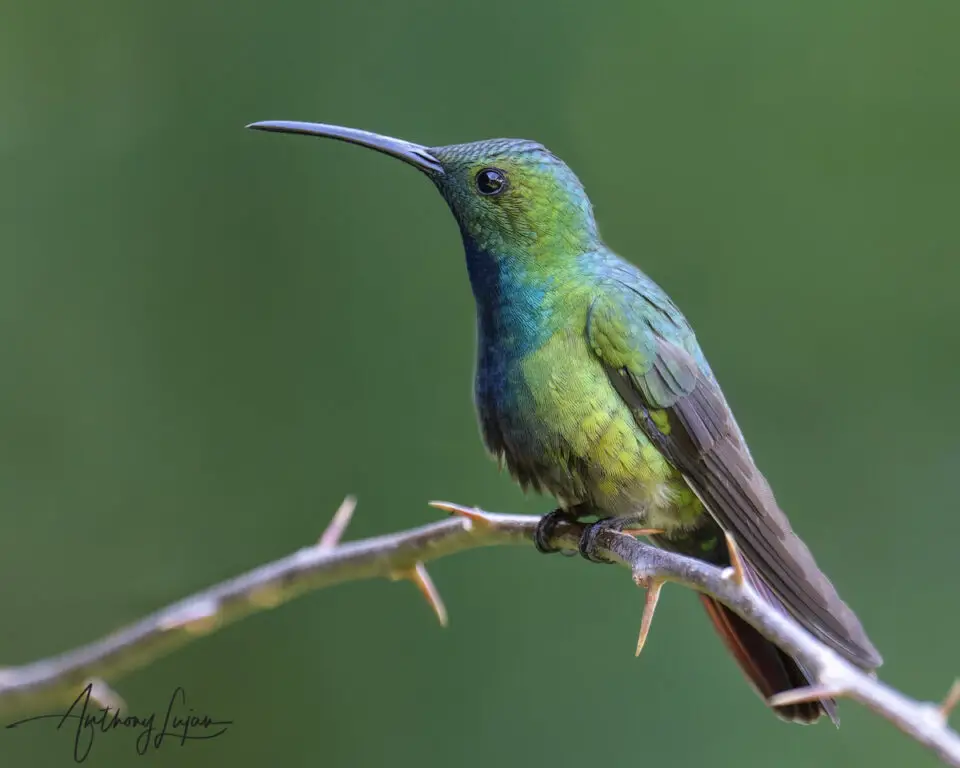
Photo by: nature.anthony.lujan

Photo by: nature.anthony.lujan

Photo by: nature.anthony.lujan
Female Green-breasted Mango hummingbirds are less vibrant looking than the males and usually do not have iridescent and distinctive sapphire gorget or turquoise crown. They have a mossy green back with black wings and a dark middle throat stretching from the throat to their underbelly. This stripe on their throat can change from black to a midnight bluish green depending on the reflection of the light.

Photo by: nature.anthony.lujan
Juvenile Green-breasted Mango hummingbirds, both male and female, look more like adult females until they are differentiated as the male begins to acquire the iridescent feathers that are typical of this species of hummingbird.
Baby Green-breasted Mango hummingbirds are easily identified by their white fluffy feathers near their bottom that will disappear as they age.
Outside of Texas, but within the United States, only three other sightings of Green-breasted Mango hummingbirds have been documented. All three sightings were seen from a personal feeder and located in North Carolina in 2000, Wisconsin in 2007 and Georgia in 2007.
See pictures and hear the sounds of the Green-breasted Mango hummingbirds
COSTA’S HUMMINGBIRD – (Calypte costae)
Conservation Status: Least concerned
Kingdom: Animalia
Phylum: Chordata
Class: Aves
Order: Apodiformes
Family: Trochilidae
Genus: Calypte
Species: C. costae
Costa’s hummingbirds are predominantly a southwestern bird found in the corners of California, Nevada, Arizona, and Mexico and are rare to Texas.
On average, out of 10,000 hummingbird sightings in Texas, 4 will be of the Costa’s hummingbird. Out of all hummingbird sightings in Texas, 0.04% will be Costa’s hummingbirds.
See Texas Costa’s sightings map
Costa’s hummingbird was named in 1839 by Jules Bourcier to commemorate Louis Marie Pantaleon Costa, the French ornithologist who was an avid collector of hummingbirds.
Male Costa’s hummingbirds are identified by their bright reddish-purple cap (head feathers) and gorget (throat feathers). Their gorget has long streaming throat feathers on both sides of their face, similar to a Calliope hummingbird. They have light greenish gray underbelly with green backs and flanks. Their size is 3-3.5 inches in length and weigh 2-3 grams.

Photo by: bird.whisperer

Photo by: hummingbirdsbysuprise

Photo by: hummingbirdsbysuprise
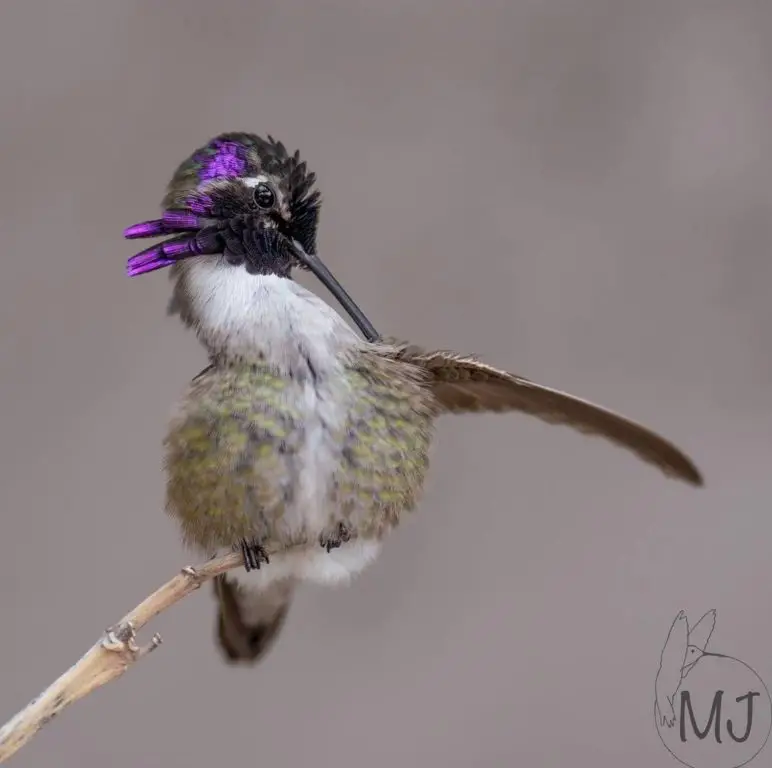
Photo by: hummingbirdsbysuprise
Note: Preening flight feathers is an important daily routine to maintain hygiene and to keep the feathers flexible, strong, in alignment, and parasite-free.
Female Costa’s hummingbirds are not as vibrant as the males and usually do not have iridescent feathers. They have a grayish-light green back with a dusty white underbelly.

Photo by: hummingbirdsbysuprise
Juvenile Costa’s hummingbirds, both male and female, look more like adult females until they are differentiated as the male begins to acquire the iridescent feathers that are typical of this species of hummingbird.
Female Costa’s hummingbirds migrate north from Mexico to breed in Arizona, California, Nevada, and Utah.
They are a desert-dwelling species and build their nests in open areas with scarce vegetative cover. They have been known to nest on the tops of cacti. The thorns of the plant act as a deterrent to predators that may attempt to eat the eggs or nestlings.

Photo by: hummingbirdsbysuprise
Note: His bright throat feathers are slowly coming in.
Baby Costa’s hummingbirds are easily identified by their white fluffy feathers near their bottom that will disappear as they age.
Very little is known about Costa’s hummingbirds and their short migratory habits in comparison to other hummingbird species.
Their habitat consists of desert scrub and washes including grasslands where they thrive on desert plants or ocotillos.
Male Costa’s hummingbirds are extremely territorial and can come across as being the meanest sheriff in town, especially when defending “their” feeders. Their aggressive conduct is equivalent to the known quarrelsome and combative behaviors of the Rufous hummingbird.
Although Costa’s hummingbirds will defend nectar sources amongst themselves, they are subordinate to larger hummingbirds and will defer to them if challenged.
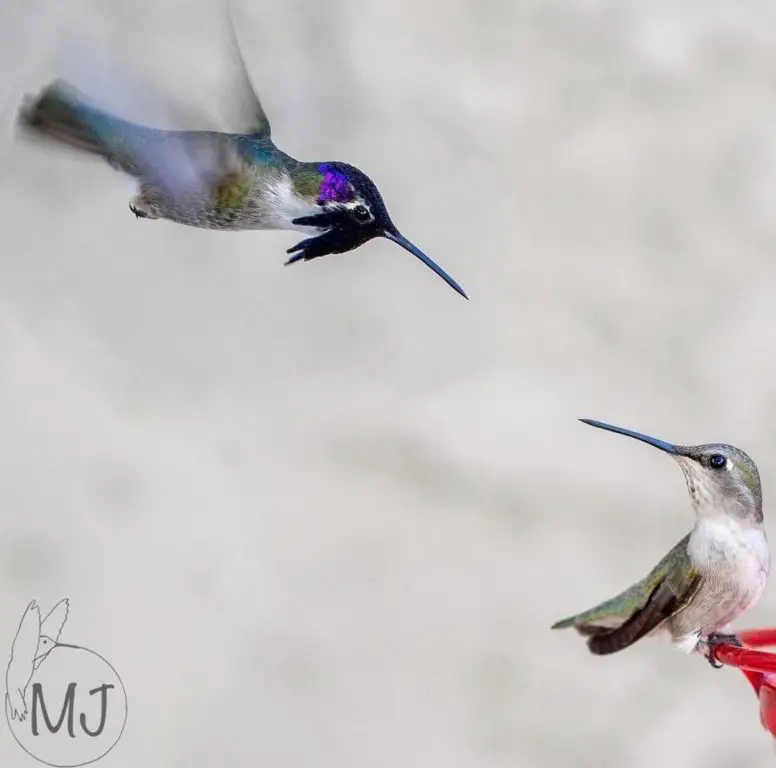
Photo by: hummingbirdsbysuprise
See my article: Why Hummingbirds Chase Each Other: Is it Friend or Foe?
They are known to interbreed or cross breed producing hybrids between Anna’s, Black-chinned, Blue-throated, Broad-tailed, and Calliope hummingbirds.
These hummingbirds have no known predators, however, the largest threat to Costa’s hummingbirds is human encroachment in the form of the desert being plowed and cleared for settlement and grazing.
During a capture and release banding operation in California, the oldest living recorded female Costa’s hummingbird was 8 years and 9 months when captured and released in 2001 and again in 2009.
See my article: 3 Reasons Why Hummingbirds Are Banded
VIOLET-CROWNED HUMMINGBIRD – (Amazilia voliceps)
Conservation Status: Least concerned
Kingdom: Animalia
Phylum: Chordata
Class: Aves
Order: Apodiformes
Family: Trochilidae
Genus: Amazilia
Species: A. voliceps
Violet-crowned hummingbirds are predominantly found in Mexico, Guatemala, and Nicaragua, therefore they are considered rare to Texas.
On average, out of 10,000 hummingbird sightings in Texas, 3 will be of the Violet-crowned hummingbird. Out of all hummingbird sightings in Texas, 0.03% will be Violet-crowned hummingbirds.
See Texas Virginia Violet-crowned sightings map
Male Violet-crowned hummingbirds are identified by their iridescent violet/blue cap of head feathers, called a crown. Unlike most hummingbirds, the Violet-crowned hummingbird does not display an iridescent gorget or ear patch markings. They derive their name from this bright purple cap of head feathers. They have a modeled gray-green pattern on their back resembling fish scales and a white underbelly covering the bottom of their beak to the full length of their body. Their size is 3 inches to 3.9 inches in length and weighs approximately 5 grams.

Photo by: hummingbirdsbysuprise
Female Violet-crowned hummingbirds usually are more drab-looking than the males and usually do not have iridescent feathers.
Juvenile Violet-crowned hummingbirds, both male and female, look more like adult females until they are differentiated as the male begins to acquire the iridescent feathers that are typical of this species of hummingbird.
Baby Violet-crowned hummingbirds are easily identified by their white fluffy feathers near their bottom that will disappear as they age.
Violet-crowned hummingbirds prefer a riparian habitat, which means they can be found in woodland areas near rivers.
There is an increase in these hummingbirds overwintering in the Southern United States increasing its habitat range annually as it moves north.
WHITE-EARED HUMMINGBIRD – (Hylocharis leucotis)
Conservation Status: Least concerned
Kingdom: Animalia
Phylum: Chordata
Class: Aves
Order: Apodiformes
Family: Trochilidae
Genus: Hylocharis
Species: H. leucotis
White-eared hummingbirds are commonly seen in Mexico and Central America, therefore they are rare vagrants to the state of Texas.
On average, out of 10,000 hummingbird sightings in Texas, 3 will be of the White-eared hummingbird. Out of all hummingbird sightings in Texas, 0.03% will be White-eared hummingbirds.
See Texas White-eared sightings map
The White-eared hummingbird gets its scientific name Hylocharis leucotis from the Latin word (hylo) “wood or matter,” (charis) derived from a Greek word meaning goddesses of beauty and grace; (leuco) in Latin means “white or without color” and (otis) meaning “ear”.
Male White-eared hummingbirds have a spectrum of green colors on their back ranging from a Granny Smith apple green to a dark emerald with patches of iridescent turquoise on their throats. In darker lighting their crown and throat can appear black. They possess a distinct and noticeable white stripe that spans from the eye to the neck. Their bill is shorter than the average hummingbird bill and is half red and black. They are 3.5-3.9 inches in length and weigh 3-4 grams.

Photo by: jordanmartin_photography

Photo by: jordanmartin_photography
Female White-eared hummingbirds are slightly duller in color than the males showing a bronzy green topside and dull gray underbellies with bright white eye accents.
Juvenile White-eared hummingbirds, both male and female, look more like adult females until they are differentiated as the male begins to acquire an iridescent turquoise on their throats and possess a distinct and noticeable thick white stripe that spans from the eye to the neck that are typical of this species of hummingbird.
The noticeable white stripe begins to develop early.
Baby White-eared hummingbirds are easily identified by their white fluffy feathers near their bottom that will disappear as they age.
Their habitat consists of pine-oak forests with tropical dry and moist coniferous forests. These climates provide constant rainfall with humidity, warm summers and colder winters.
AMETHYST-THROATED MOUNTAIN-GEM HUMMINGBIRD – (Lampornis amethystinus)
Conservation Status: Least concerned
Kingdom: Animalia
Phylum: Chordata
Class: Aves
Order: Apodiformes
Family: Trochilidae
Genus: Lampornis
Species: L. amethystinus
Amethyst throated Mountain-gem hummingbirds reside mainly in Central America and are found in Mexico, El Salvador, Guatemala and Honduras.
Amethyst-throated hummingbirds are considered extremely rare to Texas. On average, out of 400,000 hummingbirds, Texans will see only 1 Amethyst-throated Mountain-gem hummingbird. Out of all hummingbird sightings in Texas, 0.0005% will be Amethyst throated Mountain-gem hummingbirds.
See Texas Amethyst-throated Mountain-gem sightings map
Male Amethyst throated Mountain-gem hummingbird features a bright iridescent plum orchid purple gorget, with white stripes over both of its eyes. His wings and tail are dark with the tips of his tail painted white. Amethyst throated Mountain-gem hummingbirds display a dull grayish red-violet color all over its body emphasizing patches of a grayish-mulberry color on their head, neck, and the top part of the shoulder where the wing attaches.
Their size is 4.5 to 4.9 inches in length and weigh 5 to 7.8 grams. They are a large hummingbird and are slightly larger and resemble their sister species the Blue throated Mountain-gem hummingbird. They are considered the largest hummingbird seen in Texas.
Female Amethyst-throated Mountain-gem hummingbirds are less vibrant than the males and usually do not have iridescent and distinctive plum orchid throat feathers, but sport a dark cinnamon throat. They have a dark body with a dusty gray breast and underbelly.
Juvenile Amethyst-throated Mountain-gem hummingbirds, both male and female, look more like adult females until they are differentiated as the male begins to acquire the iridescent feathers that are typical of this species of hummingbird.
Baby Amethyst-throated Mountain-gem hummingbirds are easily identified by their white fluffy feathers near their bottom that will disappear as they age.
The Amethyst-throated Mountain-gem hummingbird’s habitat consists of humid tropical forests. Although the conservation status for them is marked the least concerned and is considered fairly common, recent research is documenting a gradual decline in these species due to deforestation.
See pictures and hear sounds of Amethyst-throated Mountain-gem hummingbirds
CINNAMON HUMMINGBIRD – (Amazilia rutila)
Conservation Status: Least concerned
Kingdom: Animalia
Phylum: Chordata
Class: Aves
Order: Apodiformes
Family: Trochilidae
Genus: Amazilia
Species: A. rutila
Cinnamon hummingbirds are common tropical natives found in Mexico and Central America as far south as Panama.
Even though there are no reported Cinnamon hummingbirds sightings in Texas on the sightings map, one of Google’s top ranked sites lists the Cinnamon hummingbird as being a hummingbird in Texas.
See Texas Cinnamon hummingbird sightings map
The Cinnamon hummingbird is rooted in the name “Amazilia”, a French novel legend and “rutila” or rutilus meaning red or warm radiance.
Male Cinnamon hummingbirds sport an army green helmet of head feathers, called a crown. Unlike most hummingbirds, the Cinnamon hummingbird does not display an iridescent gorget or ear patch markings. Instead, they have a warm cinnamon chestnut brown throat and underbelly. Their backs are green with forest green tips on their tail and chocolate brown wings. They have a red bill with a black tip. Their size is 3.7- 4.5 inches in length and weigh 5-5.5 grams.
A quick glance from behind, these hummingbirds closely resemble and can be confused with the Buff-bellied and Rufous-tailed hummingbirds.
Female Cinnamon hummingbirds are less vibrant looking than the males and usually do not have iridescent feathers. Their bill is mostly black with a red base.
Juvenile Cinnamon hummingbirds, both male and female, look more like adult females until they are differentiated as the male begins to acquire the iridescent feathers that are typical of this species of hummingbird. Their bill is all black in color.
Baby Cinnamon hummingbirds are easily identified by their white fluffy feathers near their bottom that will disappear as they age.
Cinnamon hummingbirds enjoy residing in deciduous subtropical and dry forests. They cross breed and form a hybrid species with the Buff-bellied hummingbird.
See pictures and hear sounds of male, female, and juvenile Cinnamon hummingbirds
Happy Hummingbird Watching!

Photo by: zebsphotography
Backyard Visitors participates in affiliate programs which compensate us for referring traffic.


